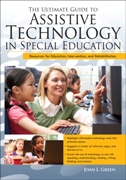The Ultimate Guide to Assistive Technology in Special Education: Resources for Education, Intervention, and Rehabilitation by Joan L. Green

Review by Kathy Kuhl
Prufrock Press. ISBN: 978-1-59363-719-4
List price $39.95. On Amazon for much less.
While technology can be a mixed blessing, it is clear we need it, we cannot escape it, and we should not want to. Technology can help our children improve their speaking, writing, reading, thinking, and memory. It can help people with vision, hearing, fine motor, and many other impairments.

But what is available is constantly changing and improving. Investigating can take huge amounts of time, even before you spend the money, and then more time and energy getting the knack of using that new tool.
How do you know what tools to use? What is the best approach to starting out in this strange, rapidly changing new area? My favorite resource is Joan L. Green. I have met her and heard her speak. This woman is a gold mine of practical information! She just wrote The Ultimate Guide to Assistive Technology in Special Education: Resources for Education, Intervention, and Rehabilitation. What is assistive technology? Any device, piece of equipment, or product that helps a person with disabilities to improve or maintain the ability to function. You will find this book helps you help your children, your elderly relatives, and others with impairments.
Why do we need assistive technology (also called adaptive technology) to help those in need? In chapter two, Joan outlines reasons. Computers are everywhere, at work, in the home, and are becoming a more and more vital part of everyday life. But a disability can keep someone from normal computer use. The solution is assistive technology, which, as Joan Green writes, can:
- “save time;
- motivate;
- make tasks easier and often more fun; …
- provide feature flexibility and customizability at a level previously impossible; …
- give independent, nonjudgmental, immediate feedback;
[so it is not the parents doing all the correcting] - provide opportunities to objectively document change over time; …
[helping parents give evidence of progress] - provide more effective studying and learning strategies” [p. 7]
She also points out other advantages. These tools can allow us to manage tasks carefully to make it easier for our children with special needs to succeed. Some technologies can help our children with communication disorders have opportunities for socialization, reducing their isolation. For example, some people on the autism spectrum prefer online communications because they do not have to try to interpret facial expression and tone of voice. While we want our children to practice those skills, that practice can be exhausting for them, and online communication can help them deepen existing friendships. (Of course parents must exercise supervision and caution, and teach their children Internet safety rules. But known acquaintances can converse online and deepen their friendship.) Students can collaborate online, developing teamwork skills.
After an introduction to computers, software, apps, and access, the bulk of Joan Green’s book covers technology to improve:
- Chapters 4 and 5: verbal expression
- Chapter 6: auditory comprehension
- Chapter 7: reading comprehension
- Chapter 8: reading skills
- Chapter 9: written expression
- Chapter 10: cognition, learning, and memory
Other chapters cover games and free online, interactive activities; Internet communications and learning tools; adapted e-mail, search engines, and web browsers.
Joan is clear, practical, and a fan of homeschooling. She can help you find cheaper alternatives. She is not reluctant to say, “This cheaper tool is good enough,” or “This free software is a great help.” She also gives private consultations and online webinars. Her website is innovativespeech.com.
Her book, The Ultimate Guide to Assistive Technology in Special Education, is available on Amazon. If you purchase it using the link below, a portion of your purchase will support this website.


One Comment